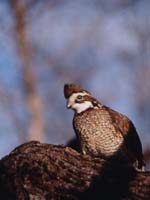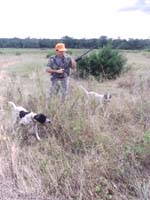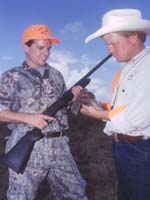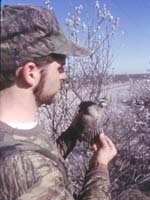
|
Features
|
|
|
|
Books
|
|
|
|
Fun & Games
|
|
|
|
Contact Us
|
|
|
John's Journal... Entry 67, Day 2
 Foshalee
Plantation's Solution to Declining Quail Populations
Foshalee
Plantation's Solution to Declining Quail Populations
EDITOR'S NOTE: In the 1800s up until the early 1900s, farmers throughout most of the South used fire every other year to control the growth of hardwoods, which also benefitted quail. Landowners would mow and chop the land after the fires. Burning, mowing and chopping would kill the top stem of a tree but had little or no effect on its root system. Continued mowing, chopping and burning never significantly improved the habitat for quail across the South.
When people quit using fire as a management tool and then stopped harrowing the ground for cotton in the mid-1900s, the land lost its native longleaf wiregrass ground cover. The loblolly pine, the short leaf pine and many other hardwoods encroached on the uplands that formerly had homed grasslands and fields.
 These
same problems affected Foshalee Plantation, made up of approximately 10,000
acres located in the Thomasville, Georgia/Tallahassee, Florida region
next door to Tall Timbers Research Station. In the early 1900s, Foshalee's
owners converted the plantation from cotton production to quail production.
However, because the people who bought the plantation didn't understand
the beneficial properties of fire, they stopped the land managers from
burning the property. Quail populations then declined.
These
same problems affected Foshalee Plantation, made up of approximately 10,000
acres located in the Thomasville, Georgia/Tallahassee, Florida region
next door to Tall Timbers Research Station. In the early 1900s, Foshalee's
owners converted the plantation from cotton production to quail production.
However, because the people who bought the plantation didn't understand
the beneficial properties of fire, they stopped the land managers from
burning the property. Quail populations then declined.
Years later Herbert Stoddard began a major research study at Tall Timbers Research Station to learn how to better manipulate habitat to produce more quail. At this time, the U.S. Government did not want anyone to promote the use of fire on wild lands for fear of wildfires. But at Tall Timbers, Stoddard proved that good timber management, quality quail management and the prevention of the spread of wildfires all depended on the prescribed use of fire.
 Since
1997, Dr. Karl V. Miller, a wildlife researcher at the University of Georgia,
Dr. William Palmer, a researcher at Tall Timbers Research Station in Tallahassee,
Florida, and Jay Welch, a University of Georgia graduate student, have
searched for ways to turn back the hands of biological time to improve
the quail habitat at Foshalee Plantation. In the process, they have found
an economical solution to a costly problem that has long vexed quail-plantation
managers.
Since
1997, Dr. Karl V. Miller, a wildlife researcher at the University of Georgia,
Dr. William Palmer, a researcher at Tall Timbers Research Station in Tallahassee,
Florida, and Jay Welch, a University of Georgia graduate student, have
searched for ways to turn back the hands of biological time to improve
the quail habitat at Foshalee Plantation. In the process, they have found
an economical solution to a costly problem that has long vexed quail-plantation
managers.
Today at Foshalee, researchers use a highly-specialized herbicide that targets low-value brush. Controlling brush improves the growth of both marketable pine trees and plants beneficial for quail. The researchers hope that the outcome of this research will, as Dr. Miller explains, "show wildlife managers throughout the south that herbicides can be a tool to restore or renovate quail habitats."
 The
researcher begins treatment with a commonly-used forestry herbicide with
imazapyr as the active ingredient in a new class of highly-selective,
low-volume herbicides. Then the biologists follow the herbicide application
with a controlled burn to encourage the growth of fresh food and cover
plants for quail.
The
researcher begins treatment with a commonly-used forestry herbicide with
imazapyr as the active ingredient in a new class of highly-selective,
low-volume herbicides. Then the biologists follow the herbicide application
with a controlled burn to encourage the growth of fresh food and cover
plants for quail.
You can buy imazapyr under the brand name Arsenal, made by BASF. Foresters treating large tracts of land can buy Arsenal Applicators Concentrate. Landowners wanting to treat smaller tracts of hardwood brush can use BASF's Habitat Release, a herbicide that contains the same chemistry as Arsenal. Both Arsenal and Habitat control hardwood brush for less cost and without as much manpower involved as the traditional management approach of chopping or mowing to control hardwood brush requires.
One application of the herbicide will get hardwoods under control and help re-establish the pines. Then you can come back and use a low-intensity treatment, such as prescribed fire without mowing, and maintain good quail habitat without such a large investment of money or manpower. After the herbicide-only and herbicide-burn treatments, forb ground cover will increase approximately 20 percent.
Tomorrow: What Quail need and How to Give It to Them
Check back each day this week for more about Improving Your Quail Hunting ...
Day 1 -Where Have All the
Wild Quail Gone
Day 2 -Foshalee Plantation's Solution to
Declining Quail Populations
Day 3 -What Quail Need and How to Give It
to Them
Day 4 -Other Ways to Have More Quail
Day 5 -Other Places to Learn About Quail
Management Programs